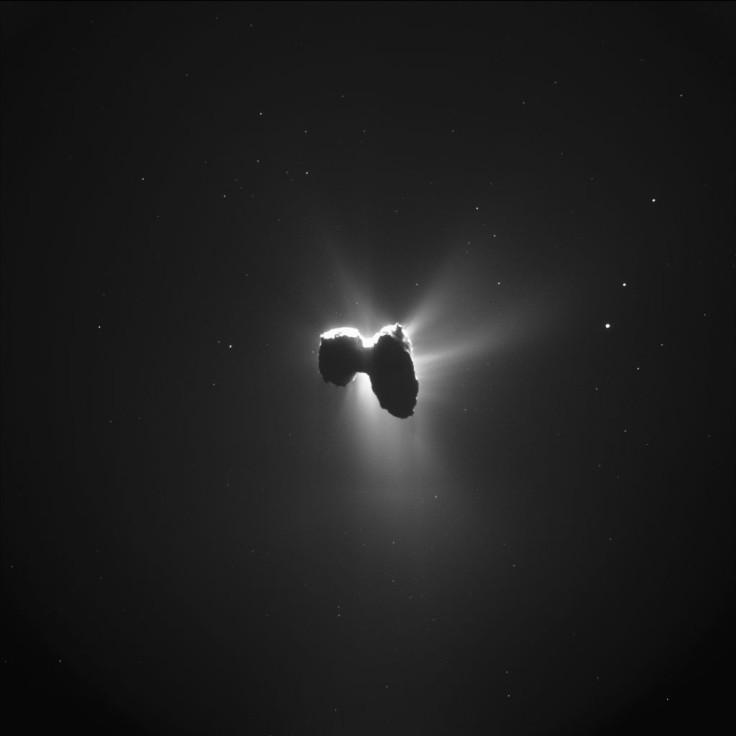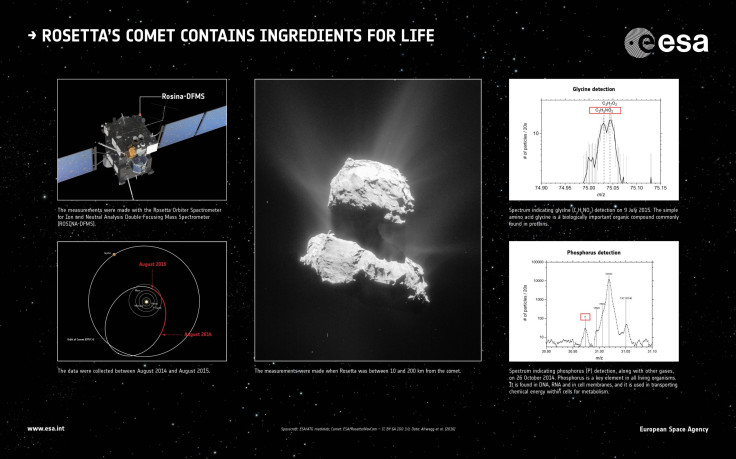Rosetta Finds Building Blocks Of Life In Comet 67P’s Fuzzy Halo

The theory of panspermia posits that life on Earth may have been seeded by meteorites and comets carrying hardy spores of microorganisms. This possibility is what makes studying comets such an exciting area of research for scientists seeking to understand the origin of life on our planet and the evolution of the solar system.
Now, a new study, based on data gathered by instruments on board the European Space Agency’s (ESA) Rosetta spacecraft — which is currently following the comet 67P/Churyumov-Gerasimenko — further bolsters the possibility that the building blocks of life on Earth may have come from outer space.
Researchers have detected the amino acid glycine, commonly found in proteins, and phosphorus, a key component of DNA and cell membranes, in the coma of the comet.
“This is the first unambiguous detection of glycine at a comet,” lead author Kathrin Altwegg, principal investigator of the ROSINA instrument that made the measurements, said in a statement. “At the same time, we also detected certain other organic molecules that can be precursors to glycine, hinting at the possible ways in which it may have formed.”

A coma is the fuzzy, nebulous envelope of dust and gas that usually surrounds a comet’s nucleus. The shape and size of the coma vary depending on the comet’s composition and its distance from the sun.
According to the study, “the presence of glycine, phosphorus, and a multitude of organic molecules, including hydrogen sulfide and hydrogen cyanide ... supports the idea that comets delivered key molecules for prebiotic chemistry throughout the solar system and, in particular, to the early Earth, drastically increasing the concentration of life-related chemicals by impact on a closed water body.”
Scientists believe that life on Earth originated nearly 3.7 billion years ago, bubbling out of a “primordial soup” rich in organic compounds. While we now have a clear picture of the evolution of life from its most ancient single-celled form to the present-day complexity we see around us, what is less clear is how the seeds of life came to exist on Earth.
“There is still a lot of uncertainty regarding the chemistry on early Earth and there is of course a huge evolutionary gap to fill between the delivery of these ingredients via cometary impacts and life taking hold,” co-author Hervé Cottin said in the statement. “But the important point is that comets have not really changed in 4.5 billion years — they grant us direct access to some of the ingredients that likely ended up in the prebiotic soup that eventually resulted in the origin of life on Earth.”
With the discovery of glycine — the simplest of all amino acids — and phosphorus, the theory of panspermia has been lent further credence.
“Demonstrating that comets are reservoirs of primitive material in the Solar System and vessels that could have transported these vital ingredients to Earth, is one of the key goals of the Rosetta mission, and we are delighted with this result,” Matt Taylor, ESA's Rosetta project scientist, said in the statement.
© Copyright IBTimes 2025. All rights reserved.






















